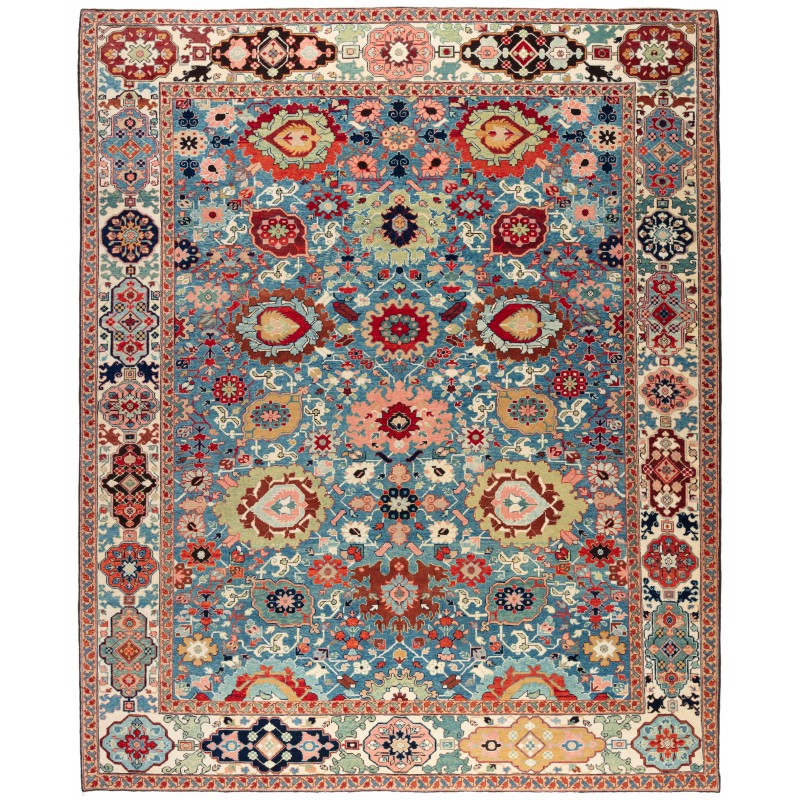
- Stock: In Stock
- Model: C50353
- サイズ: 244cm x 293cm
この絨毯の源は、ウォルター・B・デニーの著書『How to Read – Islamic Carpets』(メトロポリタン美術館、2014年ニューヨーク、図82)から来ています。これは19世紀の北西ペルシャのパルメット・ラティスデザインの絨毯の独特な例です。デザインは、鮮やかな色のパルメットが豪華で複雑な繰り返しの配列で使われており、それは17世紀の偉大な壺技法の絨毯の直系の子孫であることを示しています。
クルディスタンは、デザインの優れた絨毯と鮮やかな色の豊かな絨毯を生産した地域として、通常十分な評価を受けていません。おそらく早い時期から19世紀に至るまで、彼らは技術的には19世紀の堅固で重い二重経糸のビジャールから、このような柔軟な絨毯や非常に繊細なキリム(平織り絨毯)に至るまで、幅広い種類の絨毯を生産してきました。この例で展示されているデザインは、明らかに17世紀のモデルに由来しており、非常に人気があり、東ペルシャだけでなくコーカサス地域にも広まりました。それは18世紀にまで続き、19世紀のコーカサスの絨毯でも見ることができます。
この絨毯のデザインは、2つの大きな横方向のパルメットに囲まれた小さなパルメットの花からなる複雑なパルメットの配置に基づいています。中央の円形の花のメダリオン、このロゼットに向かっている2つの異なるデザインの大きなパルメットの形、および4つのダイヤモンド形のカルトゥーシュ(ロゼットで満たされた)が斜め軸上に配置されています。第二のパターンとして、小スケールの格子系がフィールドのほとんどの背景を埋めています。ボーダーデザインは、確立されたカルトゥーシュとスターメダリオンの連続の伝統に従っています。両方のガードストライプは、活発な角度を持つ葉状のメアンダースクロールで埋められています。この格子は無限に続いているように見えます-まるでボーダーで囲まれたセクションが見えるかのようです。この絨毯のデザインは解釈され、鮮やかな色が選ばれています。
The source of the rug comes from the book How to Read – Islamic Carpets, Walter B. Denny, The Metropolitan Museum of Art, New York 2014 fig.82. This was an exclusive example of a palmette lattice design 19th-century rug from Northwestern Persia. The design employs floral, richly complex repeating arrays of brilliant color palmettes that marks it as a lineal descendant of the great vase-technique carpets of the seventeenth century.
Kurdistan has not usually been given its due as a region that has produced rugs of considerable excellence in design and rich brilliant colors, probably from early times on, well into the 19th century. Technically they range from the solid, heavy, double-warped Bijars of the 19th century to the flexible rug of this type, and the Kilims, or flat-woven rugs of great delicacy. The design displayed in this example, clearly derived from a 17th-century model, proved so popular that it spread not only to Eastern Persia but to the Caucasus as well. It continues well into the 18th century and can still be found in Caucasian rugs of the 19th century. The design of this rug is based on an alternating succession of two large lateral palmettes surrounded by small palmette blossoms, a complex palmette arrangement composed of a central round floral medallion, four large palmette forms of two different designs facing this rosette, and four diamond-shaped cartouches, filled with rosettes, on the diagonal axis. A small-scaled trellis system fills, as a secondary pattern, most of the background of the field. The border design follows a well-established tradition of the cartouche and star medallion succession. Both guard stripes are filled with a lively angular leafy meander scroll. The lattice appears to continue into infinity – as though we can see the section that is framed by the border. The design of this rug is interpreted and vivid colors are chosen for this rug.
